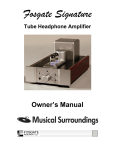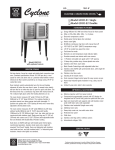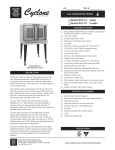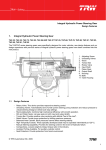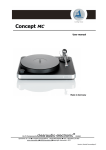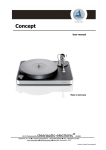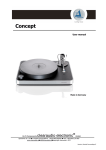Download Musical Surroundings SuperNova 2 Owner`s manual
Transcript
MUSICAL SURROUNDINGS PRESENTS: THE SUPERNOVA PHONOGRAPH PREAMPLIFIER graph SuperNova Phono Preamplifier Musical Surroundings 1 -7.5 -5 -3 2 3 -2.3 -1.7 -1 -.5 0dB left right Attenuator Status Source Sel ector OWNER’S MANUAL THE SUPERNOVA PHONOGRAPH PREAMPLIFIER TABLE OF CONTENTS 1) 2) 3) 4) 5) 6) 7) 8) INTRODUCING: THE SUPERNOVA SET-UP REAR PANEL FRONT PANEL LOADING SETTINGS GAIN SETTINGS INPUTS OUTPUTS 8.1) WHICH OUTPUT CONFIGURATION IS BEST FOR ME? 8.2) CONNECTING TO A PREAMPLIFIER (STANDARD CONFIGURATION) 8.3) CONNECTING TO A POWER AMPLIFIER (PHONODEDICATED CONFIGURATION) 8.4) -20DB/0DB SWITCH 8.5) ATTENUATION SWITCH 9) SUPERNOVA BATTERY POWER SUPPLY 10) USING THE SUPERNOVA 11) MIKE YEE’S NOTES ON THE SUPERNOVA 12) WARRANTY INFORMATION 3 PAGE 4 PAGE 5 PAGE 6 PAGE 7 PAGE 9 PAGE 10 PAGE 11 PAGE 11 PAGE PAGE 12 13 PAGE 14 PAGE 14 PAGE 14 PAGE 14 PAGE 15 PAGE 16 PAGE DIAGRAMS DIAGRAM 1: REAR PANEL DIAGRAM 2: FRONT PANEL DIAGRAM 3: LOADING SETTINGS (CHART) DIAGRAM 4: GAIN SETTINGS (CHART) DIAGRAM 5: INPUT CONNECTIONS DIAGRAM 6: STANDARD OUTPUT CONFIGURATION DIAGRAM 7: PHONO-DEDICATED CONFIGURATION 2 5 6 PAGE 8 PAGE 9 PAGE 10 PAGE 12 PAGE 13 PAGE PAGE 1) INTRODUCING: THE SUPERNOVA The SuperNova is a complete phonograph preamplifier that is designed with superior imaging in mind, providing realistic imaging of all types of music. FEATURES: ? ? ? ? ? ? ? ? The SuperNova handles up to three phono inputs. Gain settings are user-adjustable from 40 to 60 dB. Loading settings are user-adjustable from 30 Ohms to 100,000 Ohms. Independent Gain and Loading settings are available for each of the three phono inputs. There are no “signal path” switches except for the passive attenuator, if used. There are two available outputs options: a standard “line out” FIXED output, and a “phono-dedicated” VARIABLE output. A Passive Attenuator on the front of the unit controls volume when the SuperNova is connected directly to a power amp. The SuperNova uses Large Area Monolithic Super Matched Transistor Pairs for lowest noise performance. SUPERNOVA BATTERY POWER SUPPLY FEATURES: ? ? ? ? ? ? ? ? ? ? Rechargeable batteries. The charging circuits completely disconnect from the batteries when in battery mode. Optically coupled voltage monitors will wake up the processor to engage the charging of the batteries if the batteries are discharged enough. Four seven-cell NiMH “AA” battery packs provide power, one for each positive and negative power supply for each channel. There are four separate charging circuits. The positive and negative battery packs are charged separately in case there is different current usage between the positive and negative power supplies. This prevents repeated overcharging one battery pack while undercharging the other battery pack. The batteries will be “topped off” by putting the unit into charge mode if there is no activity for one week. Fully Dual Mono even when not in Battery Mode. Battery packs have an estimated life of 3+ years. Replacement Battery Packs are available through your dealer where you purchased your SuperNova. The power supply has been designed to sound excellent even without the batteries installed. 3 2) SET-UP The SuperNova is easy to set up, although, because of its flexibility, it may take some listening to fine-tune the settings to perfectly match your system and your personal tastes. Begin by removing the SuperNova and the SuperNova Battery Power Supply from the box. Set-up involves the following steps: Setting configuration of the Gain and Loading: The SuperNova is adaptable to any phonograph cartridge, with user-adjustable Gain and Loading settings that allow the user to match their moving-coil or moving-magnet cartridge to any of 256 possible Loading and 16 possible Gain settings. This feature allows the SuperNova to be custom-configured to any highend cartridge, resulting in superior imaging, amazing presence, accurate sound, and precise musicality. The settings switches for Gain and Loading are located on the SuperNova’s rear panel. See DIAGRAM 1 (page 5) for a complete explanation of the rear panel and its functions. Connecting the Inputs and Outputs: The SuperNova inputs accept up to three turntables, and features two sets of outputs, which allow the user to configure their system in two ways: 1) STANDARD (FIXED OUTPUT) CONFIGURATION (DIAGRAM 6, page 12), which delivers a standard line-level signal to a pre-amp, line-stage amp or integrated amp; 2) PHONO-DEDICATED (VARIABLE OUTPUT) CONFIGURATION (DIAGRAM 7, page 13), which delivers a variable (attenuated) signal directly into a power amp. This option bypasses the extra circuitry present in nearly every system, offering a cleaner sound and making this the preferred option for users who listen exclusively to LPs. Connecting the power source: The SuperNova connects from the rear panel to the SuperNova Battery Power Supply via the supplied Ribbon Cable, and the SuperNova Battery Power Supply then connects to the wall via the supplied Power Cord. The SuperNova front panel contains a three-position Switch Selector (to alternate between turntables), an 11-position Attenuator (for volume control when using the PHONO-DEDICATED (VARIABLE OUTPUT) CONFIGURATION), and two LEDs which indicate the status of the charging system. See DIAGRAM 2 (page 6) for a view of the front panel and explanation of the functions available. 4 3) REAR PANEL The SuperNova’s Rear Panel is designed to offer unprecedented flexibility. The unit is able to connect to up to three turntables simultaneously, with user-adjustable Gain and Loading settings for each. In the examples below, the SuperNova has been connected to three types of cartridges: a low-output moving-coil cartridge (turntable 1), a medium-output moving-coil cartridge (turntable 2), and a moving-magnet cartridge (turntable 3). Check the specifications for your cartridge(s) and adjust the Gain and Loading settings accordingly. REAR PANEL (DIAGRAM 1) TURNTABLE 2 SETTINGS: (medium-output moving-coil cartridge) GAIN: 50 db (switch 2 ON; all others OFF) LOADING: 1K ohms (switch 6 ON; all others OFF). TURNTABLE 3 SETTINGS: (moving-magnet cartridge) GAIN: 40 dbs (all switches OFF) LOADING: 50K ohms (switch 8 ON; all others OFF) TURNTABLE 1 SETTINGS: (low-output moving-coil cartridge) GAIN: 60 db (all switches ON). LOADING: 475 ohms (switch 5 ON; all othersOFF). GROUND LUG: Attach ground wire from turntable(s) here. LEFT OUTPUT (FIXED) See section 8.2 (page 12) for more details about STANDARD output configuration. TURNTABLE 1: RCA input (left) TURNTABLE 3: RCA input (left) TURNTABLE 2: RCA input (left) GAIN and LOADING: These are general settings for common configurations. For more complete tables, see secs. 5 and 6 (pages 7-9). LEFT OUTPUT (VARIABLE) See section 8.3 (page 13) for more details about PHONO-DEDICATED output configuration. -20db/0db SWITCH: See sec. 8.4 (page 14) for details. O O O N N 1 2 LEFT 3 4 5 6 7 N 1 8 2 INPUT LOADING O N 2 3 4 6 7 8 2 3 2 3 4 2 3 1 2 3 4 1 2 3 6 7 8 Pos. 1: OFF = 200 pf ON = 300 pf Pos. 2: 59 ohms Pos. 3: 121 ohms Pos. 4: 243 ohms Pos. 5: 475 ohms Pos. 6: 1,000 ohms Pos. 7: 2,000 ohms Pos. 8: 50,000 ohms ALL OFF = 10,000 ohms 2 3 4 5 6 INPUT LOADING 7 1 8 LEFT FIXED OUTPUT -20db VARIABLE OUTPUT -20db 1 2 0db 0db GROUND GAIN SWITCHES N 1 ON = UP OFF = DOWN INPUT LOADING SWITCHES O N 5 8 4 O 4 7 4 INPUT LOADING N 3 6 GAIN SWITCHES INPUT LOADING O 2 5 4 O N 1 1 3 GAIN SWITCHES GAIN SWITCHES 4 2 INPUT LOADING O N 1 1 O N 1 O N TURNTABLE 1: RCA input (right) 5 4 GAIN SWITCHES GAIN SWITCHES RIGHT 3 INPUT LOADING O N 1 GAIN SWITCHES MUSICAL SURROUNDINGS - MADE IN U.S.A. PHONO 3 PHONO 2 PHONO 1 2 3 4 5 6 7 8 Pos. 1: 56 db Pos. 2: 50 db Pos. 3: 46 db Pos. 4: 44 db NONE ON = 40 db ALL ON = 60 db FIXED OUTPUT VARIABLE OUTPUT RIGHT POWER RIGHT OUTPUT (VARIABLE) See section 8.3 (page 13) for more details about the PHONO-DEDICATED output configuration. TURNTABLE 2: RCA input (right) TURNTABLE 1 SETTINGS: (low-output moving-coil cartridge) GAIN: 60 db (all switches ON). LOADING: 475 ohms (switch 5 ON; all othersOFF). TURNTABLE 3: RCA input (right) RIGHT OUTPUT (FIXED) See section 8.2 (page 12) for more details about the STANDARD output configuration. TURNTABLE 3 SETTINGS: (moving-magnet cartridge) GAIN: 40 dbs (all switches OFF) LOADING: 50K ohms (switch 8 ON; all others OFF) TURNTABLE 2 SETTINGS: (medium-output moving-coil cartridge) GAIN: 50 db (switch 2 ON; all others OFF) LOADING: 1K ohms (switch 6 ON; all others OFF). 5 POWER MODULE (connect POWER RIBBON CABLE here) 4) FRONT PANEL The SuperNova front panel is very simple. It features a three-position switch (located on the right-hand side) which allows the user to switch between the up to three turntables that can be connected simultaneously to the unit. It also features an 11position Attenuation Switch (located on the left-hand side) which provides volume control when the SuperNova is used in the PHONO-DEDICATED (VARIABLE OUTPUT) CONFIGURATION. In the center of the front panel there are LEDs for the left and right channels indicating the status of the SuperNova’s charging system. FRONT PANEL (DIAGRAM 2) OUTPUT ATTENUATION KNOB SOURCE SELECT This feature provides volume control for when the SuperNova is hooked up directly to a Power Amplifier for optimum sound. (see PHONO-DEDICATED configuration, PG. 13) This features allows easy switching between up to three turntables. ATTENUATION SETTINGS When using the PHONO-DEDICATED configuration, the 11-step ATTENUTOR KNOB provides volume control ranging from MUTE (complete attenuation) to 0 db (no attenuation). SuperNova Phonograph Preamp Musical Surroundings -7.5 -5 -3 -2.3 -11 1 -1.7 2 3 -1 -.5 -17 mute 0db Left Right Status Output Attenuator Source Select CHARGING STATUS Separate LEFT and RIGHT channel charging status indicators for the SuperNova's completely isolated LEFT and RIGHT channels. This feature indicates the status of the Super Nova charging system. GREEN: Battery Mode. RED: Charged (or Charging) Mode. See sec. 8.4 (page 13) for more details on the charging system and the SuperNova Battery Supply unit. 6 5) LOADING SETTINGS The SuperNova is adaptable to any phono cartridge, with user-adjustable dip switches that allow the user to match their moving-coil or moving-magnet cartridge to any of 256 possible Output Loading settings. The six eight-position switch packs located on the rear panel (DIAGRAM 1, page 5) provide left and right channel settings for each turntable connected to the unit. Each switch has two settings: UP for ON and DOWN for OFF. Consult DIAGRAM 3 (page 8) and select the input loading value that corresponds most closely to the cartridge manufacturer’s recommendations, which can be found in the Owner’s Manual or at the manufacturer’s website. Use a small non-metallic tool to set the switches as directed on DIAGRAM 3 (page 8). Switch 1 controls Capacitive Loading, which is generally used with moving-magnet cartridges and has little effect on moving-coil cartridges, while switches 2-7 control Resistive Loading, which is primarily used with lower-output moving-coil cartridges. Moving-magnet and high-output moving-coil cartridges use around 50,000 Ohms (switch 8), while low-output moving-coil cartridges typically use 1,000 Ohms or less. Typically, a low-output moving-coil cartridge should be loaded to ten times its internal impedance. Thus cartridges with an internal impedance of less than ten Ohms will be more sensitive to loading settings below 300 Ohms, which are provided in the SuperNova. Capacitive Loading can be changed by adjusting Switch 1 as follows: Switch 1 OFF = 200pF. Switch 1 ON = 300pF. Resistive Loading can be changed by adjusting switches 2-8. DIAGRAM 3 (page 8) provides a general guide to choosing settings appropriate for your cartridge(s). The factory Output Loading setting for the SuperNova is 200pf/50,000 Ohms. Manufacturer’s settings for your cartridge(s) should be listed in the Owner’s Manual for your cartridge(s) or at the manufacturer’s website. After setting the switches to correspond as closely as possible to factory recommendations, you may want to fine tune the switch configurations by ear to personal taste. Typically, a lower setting provides increased focus and tighter bass, while a higher setting provides more openness. 7 LOADING SETTINGS (DIAGRAM 3) LOADING (Ohms) 31 32 33 34 35 36 38 40 41 43 45 48 50 53 56 60 64 68 74 80 87 91 96 101 107 113 120 129 137 148 160 176 193 214 240 279 322 384 480 658 1000 2000 50,000 100,000 2 3 SWITCH NUMBER 4 5 6 7 8 on on on on on on on on on on on on on on on on off off off off off off off off off off off off off off off off off off off off off off off off off off off off on on on on on on on on off off off off off off off off on on on on on on on on on on on off off off off off off off off off off off off off off off off off on on on on off off off off on on on on off off off off on on on on off off off off off off off on on on on on on on on off off off off off off off off off off off off off on on on off on off off off off off off off off off off off off on off on off on off on off on off on off on off on off on off on off on off off off off off off off off off off off off off off off off off off off off off off off off off off off off off off off off off off off off off off on on off on off off on off 8 on on off off on on off off on on off off on on off off on on off off on on on off off off off on on on on off off off off on on on on off off off off off on off on off on off on off on off on off on off on off on off on off on off off on on off off on on off off on on off off on on off off on on off off off 6) GAIN SETTINGS DIAGRAM 4 (below) provides a general guide to choosing Gain settings appropriate to your cartridge. Lower Gain settings (40dB) are intended for moving-magnet cartridges or high-output moving-coil cartridges. Higher Gain settings are intended for use with low-output moving-coil cartridges (0.5mV or so). Gain settings may be listed in the Owner’s Manual for the cartridge or at the cartridge manufacturer’s website. To set the Gain, use a small non-metallic tool to adjust change the settings. There are six switch packs (one each for left and right channels for up to three turntables). Each switch has four positions for a total of 16 possible combinations. After adjusting the Gain to match factory recommendations, settings may be further fine-tuned to personal taste. If using the PHONO-DEDICATED (VARIABLE OUTPUT) CONFIGURATION, Gain selection will also be based on your system characteristics to optimize the range of the 11-position attenuator. To reduce Gain to below 40dB use the -20dB GAIN switch located on the rear panel of the SuperNova. Note: Always let the unit settle for 60 seconds after any configuration changes are made before listening. Slowly raise the volume control; this insures the unit is stable and will not damage your system if the configuration is not set correctly. GAIN SETTINGS (DIAGRAM 4) (switch number) GAIN (dB) 40 43.5 46 48 50 51.5 52.7 53.7 55.6 56.3 56.9 57.5 58.4 58.9 59.4 59.9 1 2 3 4 OFF OFF OFF OFF OFF OFF OFF OFF ON ON ON ON ON ON ON ON OFF OFF OFF OFF ON ON ON ON OFF OFF OFF OFF ON ON ON ON OFF OFF ON ON OFF OFF ON ON OFF OFF ON ON OFF OFF ON ON OFF ON OFF ON OFF ON OFF ON OFF ON OFF ON OFF ON OFF ON 9 7) INPUTS Up to three turntables can be connected to the SuperNova simultaneously by using the PHONO 1, PHONO 2 and PHONO 3 jacks located on the back panel. Connect the left and right cables from your turntable(s) to the left and right PHONO 1, PHONO 2, and PHONO 3 INPUT jacks on the SuperNova’s back panel. If your turntable has a ground lead, connect that wire to the ground lug on the SuperNova’s rear panel. When hooking up multiple turntables and cartridges, you may have to experiment with connecting the ground leads for the turntables connected to the PHONO 2 and PHONO 3 jacks to avoid ground loops. If you have less than three turntables but multiple cartridges, you may configure the Load and Gain of the various inputs to the different cartridges to optimize each cartridge. Then, you only need to plug your tonearm cable into the appropriately configured input when using that specific cartridge. Take caution when connecting and disconnect tonearm cables not to damage delicate RCA connections on those cables. It is recommended that all equipment (amps, turntables, etc.) be turned off when connecting any audio equipment. INPUT CONNECTIONS (DIAGRAM 5) TURNTABLE 1 LEFT and RIGHT RCA jack outputs from each turntable are plugged into the SuperNova's back panel. TURNTABLE 3 TURNTABLE 2 Musical Surroundings -7.5 -5 -3 -2.3 -11 SuperNova Phonograph Preamp 1 -1.7 2 3 -1 -.5 -17 mute 0db Left Right Status Output Attenuator Source Select SUPERNOVA 10 8) OUTPUTS 8.1) WHICH OUTPUT CONFIGURATION IS BEST FOR ME? The SuperNova features two sets of left and right outputs (VARIABLE and FIXED), which allows the user to configure a system in one of two ways: 1) a STANDARD (FIXED OUTPUT) CONFIGURATION, which delivers a standard line-level signal to a pre-amp, line-stage amp, integrated amp or receiver. This is a typical configuration for most home systems where there are multiple input sources, such as a CD player or tuner in addition to a phonograph. 2) a PHONO-DEDICATED (VARIABLE OUTPUT) CONFIGURATION, which delivers a variable (attenuated) signal directly into a power amp. This option bypasses the extra circuitry present in nearly every system. Although, for reasons of convenience, many users will select the first option, this second offers an extraordinarily clean signal, making this a preferred option for users who listen exclusively to LPs. Most users (those who want to use their system to listen to CDs and radio in addition to LPs) will connect their SuperNova in the STANDARD CONFIGURATION. In this case the SuperNova will be connected to the LINE IN jacks of their preamplifier, line-stage amplifier, integrated amplifier or receiver. Receivers and integrated amplifiers will then connect directly to the speaker system, while preamps and line-stage amps will connect to a power amp (which is then connected to the speaker system). This is the configuration that most users are accustomed to, the proper set-up for those wishing to easily switch from tuner to CDs to LPs. This set-up allows all of your components to be connected through standard line-level inputs into a single preamplifier. This allows the user to control volume for all of the components from one location and to easily switch functions. But if you listen mostly to LPs, and do not mind having a system dedicated solely to that, we recommend the PHONO-DEDICATED (VARIABLE OUTPUT) CONFIGURATION. In this case the SuperNova connects directly to a power amp. This configuration eliminates impediments (such as extra gain stages, connections, switches and cabling) from the system that disrupts the signal, and is an extremely effective set-up for obtaining the cleanest possible sound. Since a power amp generally does not feature independent volume control, in the PHONO-DEDICATED (VARIABLE OUTPUT) CONFIGURATION the volume is controlled by the 11step passive attenuator switch located on the SuperNova’s front panel. When using the STANDARD (FIXED OUTPUT) CONFIGURATION, the attenuator switch is not active. DIAGRAM 6 (page 12) demonstrates a typical set-up in the STANDARD (FIXED OUTPUT) which is the set-up that most users will choose. CONFIGURATION, DIAGRAM 7 (page 13) illustrates the PHONO-DEDICATED (VARIABLE OUTPUT) CONFIGURATION, in which the SuperNova is hooked up directly to a power amp. 11 8.2) CONNECTING TO A PREAMPLIFIER (STANDARD CONFIGURATION) Most users will probably use the STANDARD CONFIGURATION, in which a turntable (or turntables) are connected to a preamplifier, line-stage amplifier, integrated amplifier or receiver. These units contain inputs for several devices as well as master volume and other controls. If using a line-stage preamp, this preamp is then connected to a power amp, which is then connected to the speaker system. In this configuration, use high-quality cables to connect the left and right FIXED OUTPUT jacks located on the SuperNova’s Rear Panel to the left and right LINE IN jacks of your preamplifier, line-stage amplifier, integrated amplifier or receiver. The INPUT jacks on your receiver or preamplifier may be labeled “LINE 1, LINE 2, etc.” or “AUX 1, AUX 2”. DO NOT PLUG THE SUPERNOVA INTO ANOTHER COMPONENT’S “PHONO” INPUT. The SuperNova is designed to replace such circuitry. STANDARD OUTPUT CONFIGURATION (DIAGRAM 6) TURNTABLE 3 TURNTABLE 2 TURNTABLE 1 Musical Surroundings -7.5 -5 -3 -2.3 -11 SuperNova Phonograph Preamp 1 -1.7 2 3 -1 -.5 -17 mute 0db Left Right Status Output Attenuator Source Select SUPERNOVA TUNER CD PLAYER PREAMPLIFIER SPEAKER POWER AMPLIFIER 12 SPEAKER 8.3) CONNECTING TO A POWER AMP (PHONO-DEDICATED CONFIGURATION) The PHONO-DEDICATED (VARIABLE OUTPUT) CONFIGURATION allows the user to connect: 1): their turntable(s) to the SuperNova; and 2): the SuperNova directly to a power amplifier. Use high-quality interconnect cables to connect the SuperNova’s left and right Variable Output jacks to the LINE IN jacks of your power amp. Select the appropriate Gain setting on the 4-position Gain switch for the most accurate rendition of the recording and the listening levels you prefer. Typically, Gain is lower for the PHONO-DEDICATED CONFIGURATION than for the STANDARD CONFIGURATION. If using the PHONO-DEDICATED CONFIGURATION, Gain settings (based on your phono cartridge output level and your system characteristics) can be used to further optimize the range of the 11-position attenuator. It is recommended that all equipment (amps, turntables, etc.) be turned OFF when connecting any audio components. PHONO-DEDICATED OUTPUT CONFIGURATION (DIAGRAM 7) TURNTABLE 1 TURNTABLE 3 TURNTABLE 2 SuperNova Phonograph Preamp Musical Surroundings -7.5 -5 -3 -2.3 -11 1 -1.7 2 3 -1 -.5 -17 mute 0db Left Right Status Output Attenuator Source Select SUPERNOVA SPEAKER SPEAKER POWER AMPLIFIER 13 8.4) -20DB/0DB SWITCH For certain high-output moving-coil or moving–magnet cartridges you may find it desirable to reduce Gain to below 40dB. Use a small non-metallic tool to adjust the -20dB/0dB Gain Switch on the Rear Panel of the SuperNova. 8.5) ATTENUATION Since a power amp generally does not feature independent volume control, in the PHONO-DEDICATED (VARIABLE OUTPUT) CONFIGURATION the volume is controlled by an 11step Passive Attenuator Switch located on the SuperNova’s Front Panel. The 11position Attenuator Switch features incremental steps from MUTE (complete attenuation) to -0dB (no attenuation) and serves as a volume control when the unit is directly connected to a power amp. When using the STANDARD (FIXED OUTPUT) CONFIGURATION, the Attenuator Switch is not active. 9) BATTERY POWER SUPPLY The SuperNova Battery Power Supply connects to a wall outlet by standard plug, and to the SuperNova via the supplied ribbon cable, which clips into place. Use care not to bend or crinkle the ribbon cable. The LED on the Front Panel of the SuperNova Battery Supply indicates the CHARGING STATUS of the unit. The four states of the Charge Cycle are: 1) GREEN (Battery Mode); 2) STEADY RED (Charging Mode); 3) SLOWLY BLINKING RED (indicates that the unit is charging -- when it is fully charged it will become STEADY RED); 4) RAPIDLY BLINKING RED (indicates a problem with the charging system). A Mode Switch on the front of the unit allows switching between Battery Mode and Charging Mode. When the unit is switched to Battery Mode (GREEN), the batteries (and the SuperNova) will be disconnected from the wall power and isolated from the associated magnetic fields. The unit will operate for at least three hours in Battery Mode. The unit will play fine in any stage of the Charge Cycle, but for best results use the unit in Battery Mode. To begin a listening session, switch the unit into Battery Mode (GREEN). When you have finished listening, switch the unit back into Charging Mode (RED). If you forget to do this, the unit itself will sense the batteries reaching a discharged state and will initiate the charging cycle. However, we recommend that you not let the batteries discharge to this degree frequently. To use the unit correctly, place it in Battery Mode (GREEN) before a listening session and return it to Charging Mode (RED) when finished. This will maximize the life of your battery packs. 10) USING THE SUPERNOVA The SuperNova is now ready to use. All high-fidelity equipment sounds best after a warm-up period, and for the SuperNova we recommend one hour. Place a record on your turntable, cue down the stylus, and slowly raise the volume control on your line preamplifier or on the SuperNova (this insures the unit is stable and will not damage your system if the configuration is not set correctly). Now just sit back and enjoy the 14 music. For best performance, the SuperNova should be left ON when not in use (in Charging Mode). Remember to let the SuperNova warm-up for one hour if you should disconnect it. 11) MIKE YEE’S NOTES ON THE SUPERNOVA The SuperNova is a three-input phono preamplifier intended for use with more than one turntable or a turntable with more than one tonearm. There is user-adjustable loading and gain for each of the inputs. The loading and gain is set via switches and is accessible from the rear of the chassis. The SuperNova switching between the inputs does not actually switch the inputs and loading, but rather by three independent front ends that are switched by means of switching the current source to one of the front ends. The outputs of the front ends are summed into the back-end circuitry. In this way no switching occurs in the signal path when not using the switched attenuator. The SuperNova is fully dual mono and is powered from a remote dual mono power supply. The remote power supply supports NiMH rechargeable batteries but is designed to work perfectly without the batteries. The batteries will allow the SuperNova to run completely isolated from the wall power for a period of three hours. There are four independent charging circuits for the four battery packs. The SuperNova has an 11-position switched attenuator output that allows "direct output" to a power amplifier. HOW THE LIMITED ATTENUATOR WORKS: Gain in a typical system: Moving-coil Phono Stage 60dB Line Amp 18dB Power Amp 30dB ____ Total Gain = 108dB Required Attenuation = -30dB Gain with a Limited Attenuator and SuperNova: Moving-coil Phono Stage Power Amp 40dB 30dB ____ Total Gain = 70 dB Required Attenuation = -5dB Most Audio systems have far too much gain. The excess gain needs to be reduced by setting an attenuator by a typical -30dB. By fine-tuning the SuperNova Gain Switches and using the Limited Attenuator, typical listening can be done with little or no attenuation. By reducing unneeded gain, the system does not need to work as hard, thereby achieving a more natural sound. The extra 25dB gain equates to about 20 times more work. Imagine working 20 times harder than you need to? The Limited Attenuator has a major advantage over a Passive Attenuator. A Passive Attenuator typically has significant output impedance creating sensitivity to the particular type of output cable. The Limited Attenuator has much lower output impedance. 15 12) WARRANTY INFORMATION Fill out the enclosed warranty card and return it to us within 30 days with a copy of your sales receipt. The unit is fully warranted against failure for three years after purchase. The warranty covers parts and labor. Damage due to improper use, modifications or acts of nature are not covered by this warranty. We will not assume any liability for any damage to any other component in the system due to a failure in the SuperNova. If you believe your SuperNova is malfunctioning, please contact the dealer where you purchased the unit, or contact Musical Surroundings at: telephone: (510) 547-5006 ext 101 fax: (510) 547-5009 email: [email protected] If the unit must be returned for repair, contact Musical Surroundings at the phone number above. A Return Authorization must be issued prior to you returning your SuperNova for service. For more information on the SuperNova see the Musical Surroundings website at musicalsurroundings.com or Mike Yee’s website at MichaelYeeAudio.com. 16

















